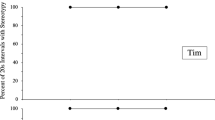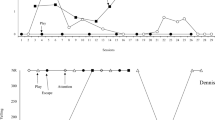Abstract
Differential reinforcement of other behavior (DRO) and self-monitoring was used to reduce repetitive challenging behavior in the form of eyelash, eyebrow, and hair pulling exhibited by a 19-year-old woman with an autism spectrum disorder. Treatment evaluation included DRO with competing and non-competing stimuli in a private therapy room. Once the DRO interval exceeded 10 min, treatment was conducted in the participant’s classroom. Results of the study suggested DRO was successful in both environments and across both stimulus types.





Similar content being viewed by others
References
American Psychiatric Association. (2000). Diagnostic and statistical manual of mental disorders-text revision (4th ed.). Washington, DC: Author.
Centers for Disease Control and Prevention (2012). Prevalence of autism spectrum disorders—Autism and developmental disabilities monitoring network, United States, 2008. Surveillance summaries. Morbidity and Mortality Weekly Report. 61 (No. SS-03). Retrieve from http://www.cdc.gov/mmwr/pdf/ss/ss6103.pdf
Chowdhury, M., & Benson, B. A. (2011). Use of differential reinforcement to reduce behavior problems in adults with intellectual disabilities: A methodological review. Research in Developmental Disabilities, 32, 383–394.
Cowdery, G. E., Iwata, B. A., & Pace, G. M. (1990). Effects and side effects of DRO as treatment for self-injurious behavior. Journal of Applied Behavior Analysis, 23, 497–506.
Fisher, W. W., Piazza, C. C., Bowman, L. G., Hagopian, L. P., Owens, J. C., & Slevin, I. (1992). A comparison of two approaches for identifying reinforcers for persons with sever and profound disabilities. Journal of Applied Behavior Analysis, 25, 491–498.
Iwata, B. A., & Dozier, C. L. (2008). Clinical application of functional analysis methodology. Behavior Analysis in Practice, 1, 3–9.
Iwata, B. A., Dorsey, M. F., Slifer, K. J., Bauman, K. E., & Richman, G. S. (1994a). Toward a functional analysis of self-injury. Journal of Applied Behavior Analysis, 27, 197–209. Reprinted from Analysis and Intervention in Developmental Disabilities, 2, 3–20, 1982.
Iwata, B. A., Pace, G. M., Dorsey, M. F., Zarcone, J. R., Vollmer, T. R., Smith, R. G., Rodgers, T. A., Lerman, D. C., Shore, B. A., Mazaleski, J. L., Goh, H., Cowdery, G. E., Kalsher, M. J., & Willis, K. D. (1994b). The functions of self-injurious behavior: an experimental-epidemiological analysis. Journal of Applied Behavior Analysis, 27, 215–240.
Kliebert, M. L., Tiger, J. H., & Toussaint, K. A. (2011). An approach to identifying the conditions under which response interruption will reduce automatically reinforced problem behavior. Behavior Analysis in Practice, 4, 17–26.
Matson, J. L., & Dempsey, T. (2008). Stereotypy in adults with autism spectrum disorders: relationship and diagnostic fidelity. Journal of Developmental and Physical Disabilities, 20, 15–165.
Matson, J. L., Dempsey, T., & Fodstad, J. C. (2009). Stereotypies and repetitive/restrictive behaviors in infants with autism and pervasive developmental disorder. Developmental Neurorehabilitation, 12, 122–127.
Matson, J. L., & Vollmer, T. R. (1995). The questions about behavioral function (QABF): Users guide. Baton Rouge: Disability Consultants, L. L. C.
Piazza, C. C., Fisher, W. W., Hanley, G. P., LeBlanc, L. A., Worsdell, A. S., Lindauer, S. E., & Keeney, K. M. (1998). Treatment of pica through multiple analyses of its reinforcing functions. Journal of Applied Behavior Analysis, 31, 165–189.
Rapp, J. T., & Vollmer, T. R. (2005). Stereotypy 1: a review of behavioral assessment and treatment. Research in Developmental Disabilities, 26, 527–547.
Ringdahl, J. E., Vollmer, T. R., Marcus, B. A., & Roane, H. S. (1997). An evaluation of environmental enrichment: the role of stimulus preference. Journal of Applied Behavior Analysis, 30, 203–216.
Ringdahl, J. E., Andelman, M. S., Kitsukawa, K., Winborn, L. C., Barretto, A., & Wacker, D. P. (2002). Evaluation and treatment of covert stereotypy. Behavioral Interventions, 17, 43–49.
Shabani, D. B., Wilder, D. A., & Flood, W. A. (2001). Reducing stereotypic behavior through discrimination training, differential reinforcement of other behavior, and self-monitoring. Behavioral Interventions, 16, 279–286.
Shore, B. A., DeLeon, I. G., Kahng, S. W., & Smith, R. G. (1997). An analysis of reinforcer substitutability using object manipulation and self-injury as competing responses. Journal of Applied Behavior Analysis, 30, 21–41.
Taylor, B. A., Hoch, H., & Weissman, M. (2005). The analysis and treatment of vocal stereotypy in a child with autism. Behavioral Interventions, 20, 239–253.
Tiger, J. H., Fisher, W. W., & Bouxsein, K. J. (2009). Therapist- and self-monitored DRO contingencies as a treatment for the self-injurious skin picking of a young man with Asperger syndrome. Journal of Applied Behavior Analysis, 42, 315–319.
Vollmer, T. R., Iwata, B. A., Zarcone, J. R., Smith, R. G., & Mazeleski, J. L. (1993). The role of attention in the treatment of attention maintained self-injurious behavior: noncontingent reinforcement and differential reinforcement of other behavior. Journal of Applied Behavior Analysis, 26, 9–21.
Woods, D. W. (2002). Introduction to the special issue on repetitive behavior problems. Behavior Modification, 26, 315–319.
Woods, D. W., Friman, P. C., & Teng, E. J. (2001). Physical and social impairment in persons with repetitive behavior disorders. In D. W. Woods & R. G. Miltenberger (Eds.), Tic disorders, trichotillomania, and other repetitive behavior disorders: Behavioral approaches to analysis and treatment (pp. 33–52). Boston: Kluwer.
Author information
Authors and Affiliations
Corresponding author
Rights and permissions
About this article
Cite this article
Nuernberger, J.E., Vargo, K.K. & Ringdahl, J.E. An Application of Differential Reinforcement of Other Behavior and Self-Monitoring to Address Repetitive Behavior. J Dev Phys Disabil 25, 105–117 (2013). https://doi.org/10.1007/s10882-012-9309-x
Published:
Issue Date:
DOI: https://doi.org/10.1007/s10882-012-9309-x




